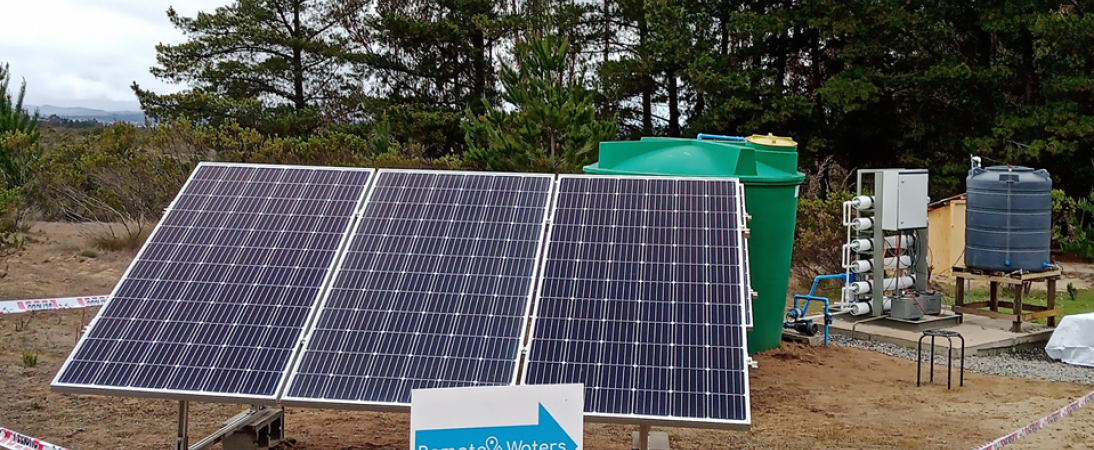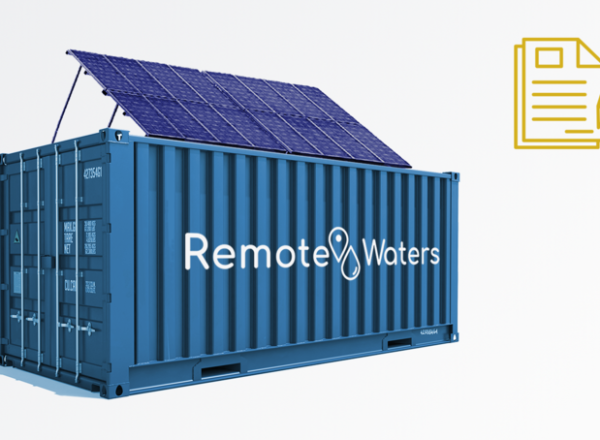Innovations

Remote Waters Blue Economy Innovation
Remote Waters offers a sustainable low cost water desalination system that can be powered by solar energy.
The problem
Today, 11% of the world's population has limited clean water access and up to 20% when considering only rural areas of the world. In Chile during the 1980s building a well was a popular low investment solution for gaining access to drinkable water but nowadays it costs near USD 30,000 to build a deep well that might have water - an investment that’s inaccessible for many low income rural communities. Infrastructure to bring water to remote rural communities is too expensive for the governments and water brought in trucks by local municipalities is limited and often too costly. Water insecurity is the new reality particularly for the rural communities where water supply is strictly rationed or when there is no supply at all. Water shortage and consumption of dirty water may cause health issues such as diarrhea and anemia. Locals are often forced to purchase bottled water that is up to 1000 times more expensive than tap water.
Furthermore, the decrease in precipitation levels across Chile caused by climate change are negatively impacting the region's agricultural yield, while water scarcity and limited access to water rights further prohibits other industries such as real estate and tourism from developing and supporting the economic development of the country.
The solution
To address the issue of water insecurity and poor water quality in rural communities particularly in coastal areas, Remote Waters offers a sustainable low cost water desalination system that can be powered by solar energy. The small-scale off grid system can be set up in 3 months, requires low maintenance and offers the possibility for modular expansion. This innovative solution secures clean water for drinking as well as cleaning, irrigation and animal consumption directly supporting the livelihoods of rural communities.
Remote waters currently offers the water purification system both for rent and sale.
How it Works
First step in the process is to secure a water source that can be seawater, water from a river or lake, brackish water or any other type of water that is contaminated or unfit for consumption. A thorough water analysis is performed to determine the extent of purification required that way offering custom solutions and minimizing unnecessary costs. Once inside the unit, the water is then filtered through membrane technology using primarily renewable solar energy and allowing for zero CO2 emissions. Salt brine is then extracted and discarded. As the last step of the process, the water is transferred to a pressurised water system or an elevated water tank to facilitate the water delivery to nearby houses.
All units are equipped with cameras for security, while the system itself can be operated and monitored remotely which lowers maintenance costs and allows for quick and efficient problem detections and resolution. One system has the capacity for purifying one cubic meter of water per hour equivalent to approximately 1000 liters and enough to supply water for 20-40 households depending on water consumption. In just one day the system can provide up to 23 000 litres or enough water for up to 1000 households. Remote Waters can also custom design.
Goals
Remote Waters aims to utilise clean technology for poverty and hunger relief, and overall health improvement of rural communities in Chile and globally.
The company not only wants to provide clean water but in doing so will try to raise awareness and educate people about water quality and its effects on our health. To accomplish these broader goals and as part of their growth plan, remote Waters will pursue strategic public, private and nonprofit sector partnerships. It will seek to empower community leaders through learning and understanding the product functionality to become their product ambassadors in order to build trust amongst all community members.
Remote Waters has aligned and operates in accordance with the United Nations Sustainable Development Goals (SDGs) directly contributing to poverty reduction (SDG 1), providing quality education (SDG 4), clean water and sanitation (SDG 6) and decent work and economic growth (SDG 8).
Challenges
Shortage of accessible financial streams can be considered as one of the main challenges to the project to date. Moreover, governments rarely recognise the potential of innovative solutions and, as a consequence, the government contract bidding process can be favourable for established industry leaders. Investment however is essential for production workshop expansion and scalable international growth of Remote Waters.
Impacts to Date
By participating in international competitions the company has been able to attract a lot and much needed national and international media attention and coverage of their innovative solutions to rural water scarcity, particularly in the early stages of product development.
As substantial water users, large international brands such as Coca Cola and various large beer companies have initiated partnership discussions with Remote Waters to explore possible CSR initiatives and give back to the communities.
To date Remote Waters has installed 7 water purification units in Chile helping thousands of households change their life for the better.
What's Next
In the coming 2-3 years Remote Waters hopes to successfully deliver and implement 100 water purification systems.
The company is currently in its expansion stage first entering Panama and later aiming to penetrate other Latin American markets. Successful and impactful international expansion will undoubtedly require strong partnerships not only with local governments and local water companies to assist with the unit maintenance but potentially other industries such as tourism and other green tech sectors.
